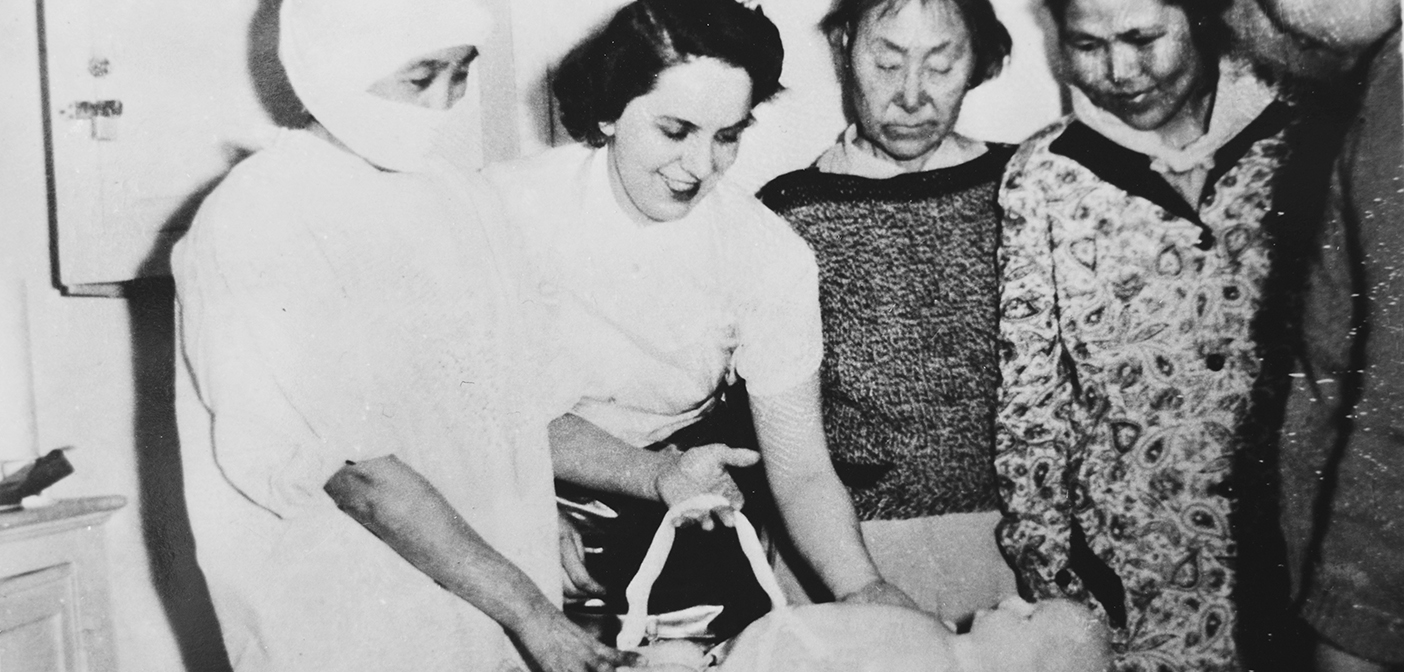By Steve St. Angelo
Bertha Louise Bloomer Johnson, ’44, took healthcare to the hinterlands
[vc_gallery type=”flexslider_fade” interval=”3″ images=”18794,18795,18796″ onclick=”link_no” custom_links_target=”_self” img_size=”full”]Photos Courtesy of Elizabeth Morrow | Bertha Louise Bloomer Johnson left Johns Hopkins in 1944 for rural Kentucky, reaching underserved patients by horseback. Then she set off for Alaska. By jeep, small plane, boat, sled, and on foot, Bloomer Johnson went village to village teaching midwifery. “She’s one of the most adventurous women I’ve had the pleasure of knowing,” says Elizabeth Morrow of her grandmother, whose gorgeous parka she also has had the pleasure of wearing. Morrow hopes to write a book about Bloomer Johnson’s adventures.
If this parka could talk, it would probably have to stop and catch its breath a bunch of times while telling the story of adventure and caring that has been the life of Bertha Louise Bloomer Johnson, ’44.
Bloomer Johnson trudged off from Johns Hopkins in the Forties to the backcountry of Kentucky, where she reached underserved patients by horseback. From there she embarked for an Alaska even more harsh and remote than today’s 49th state and never looked back.
By jeep, small plane, boat, sled, and on foot, Bloomer Johnson traversed the frontier to share her midwife skills with native Alaskans (often in a gorgeous fur parka with wolverine ruff that remains in lovely shape). “Most of the babies in those days were born in the villages and they had untrained women as their midwives,” Bloomer Johnson notes. So she wrote and hand illustrated a library of nurse/midwife training booklets and pamphlets that were published by the State of Alaska and spread like apple seeds as Bloomer Johnson went from village to village.
Photos show her cheerfully instructing local women on maternal care with mannekins. She was stationed in Naknek, on Bristol Bay, and would travel around to the villages in that area, teaching midwifery and leading general health clinics. It was the perfect life for someone with an aversion to administrative work and little interest in the traditional nurse manager track. “A lot of the trouble with any of those things is that the people who get promoted to those jobs are often the ones that have been wonderful working with people, and they don’t like really doing the administrative work,” she explains. “I can’t picture me ever having been successful at that.”
Upon graduating from Johns Hopkins, Bloomer Johnson got her own midwife training through the Frontier Nursing Service in Kentucky, providing prenatal and maternal care for women in the state’s backcountry. Hired by the Territory of Alaska as a public health nurse, she worked to slow alarming death rates among mothers and babies. “She drove up to Alaska in her jeep with just her dog, Rusty, and one of her good girlfriends the first year the Alaska Canada Highway was open to civilians,” remarks granddaughter Elizabeth Morrow, who is writing a book about Bloomer Johnson, now 93. The trip took more than a week, Bloomer Johnson remembers: “The Alaska Highway then was kind of the end of the earth, so to speak, and you could hardly find out anything about it! It wasn’t as bad as I thought it was going to be. We had a lot worse roads in Kentucky than the Alaska Highway.”
“She’s one of the most adventurous women I’ve had the pleasure of knowing,” says Morrow of her grandmother, who lives at the Pioneer Home in Sitka with husband Martin, a carpenter she met during a rehab project on her house/clinic in Naknek and married 63 years ago.
Now the recipient of far more care than she gives, what does Bloomer Johnson think of the healthcare in Alaska that she helped lay the groundwork for?
“I think about what the village clinics are now … wow! That would’ve been really something!” Bloomer Johnson explains. “The village nurses on the Internet can send pictures [to larger health centers] if they have somebody with a bad wound or something like that. If you have a rash, they can send that in and get some help with what’s really causing it. We just went by guess and by golly and whatever we could explain in words, you know?”
